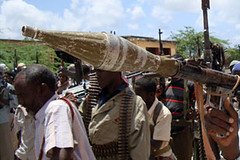
Islamic resistance fighters in Somalia have been struggling to overturn the US-backed regime in Mogadishu. Fighters from Hizbul Islam have joined al-Shabab in an offensive against the government.
Originally uploaded by Pan-African News Wire File Photos
1 June 2009
Somalia — Fresh fighting between the transitional government forces and forces against them has started near the police station of Yaqshid district in the Somali capital Mogadishu, witnesses told shabelle radio on Monday.
Reports from the area of the fighting say that the government soldiers took over the control of the police station of Yaqshid district as bitter fighting between the two sides is continuing there.
Residents told shabelle radio that both sides of the fighting are using heavy weapons in and around the district adding that it is too difficult for the residents to be out of their houses due to the gunfire of the fighting.
No casualty has been reported so far as the sound of heavy gun battle could be heard parts of the Somali capital Mogadishu.
There is no word from the two warring sides.
The reason of the fighting is unclear yet and it comes as fighting between the two sides erupted there on Sunday.
2009-05-25
208 killed in two weeks of Mogadishu fighting
Garweyne: 80 percent of killed are civilians caught in crossfire between Somali government, insurgents
MOGADISHU - More than two weeks of fighting between pro-government forces and insurgents in the Somali capital have left at least 208 people dead and 700 wounded, a government minister said.
"We have conducted a count and 208 people have been killed so far while more than 700 have been wounded," Minister for Humanitarian Affairs Mohamoud Ibrahim Garweyne told a press conference in Mogadishu late Sunday.
The latest round of bloodletting in the Somali capital kicked off on May 7 when hardline groups launched a fresh offensive aimed at removing internationally-backed President Sharif Sheikh Ahmed.
Sharif and a handful of ministers have been holed up in the presidential compound for days, with little firepower of their own to repel the insurgents and African Union (AU) peacekeepers holding the fort.
"I can tell you that 80 percent of the people killed and injured are civilians who were caught in the crossfire," Garweyne said.
"The clashes have also displaced 8,367 families, who have reached temporary camps outside the capital where their livelihoods are very precarious," the minister said.
Over the weekend, the United Nations put the number of people displaced by the latest fighting at 57,000.
The seaside capital has been ravaged by 18 years of almost uninterrupted civil conflict and hundreds of thousands of people had already fled following Ethiopia's invasion in late 2006.
The Ethiopian army invaded Somalia in late 2006 to rescue Somalia's embattled transitional government and oust the Islamic Courts Union (ICU), which controlled of much of the country's central and southern regions.
The ICU had ruled much of Somalia with relative peace and prosperity until the Ethiopian involvement.
Since then, ICU fighters have waged a deadly insurgency against the Ethiopian and the transitional government forces.
But Ethiopian troops’ retaliations have caused many casualties among Somali civilians.
Since the Ethiopian invasion, about one million Somalis have fled their homes. An estimated 6,500 civilians have been killed.
Aid workers estimate 2.6 million Somalis needed assistance.
In May 2008, Amnesty International accused the Ethiopian troops in Somalia of increasingly resorting to throat-slitting executions, highlighting an "increasing incidence" of gruesome methods by Ethiopian forces that include rape and torture.
Since the ousting of the ICU, Somalia had plunged into unprecedented chaos, where warlords and pirates have returned to the scene.
Somalia is still struggling for stability despite the Ethiopian withdrawal.
No comments:
Post a Comment